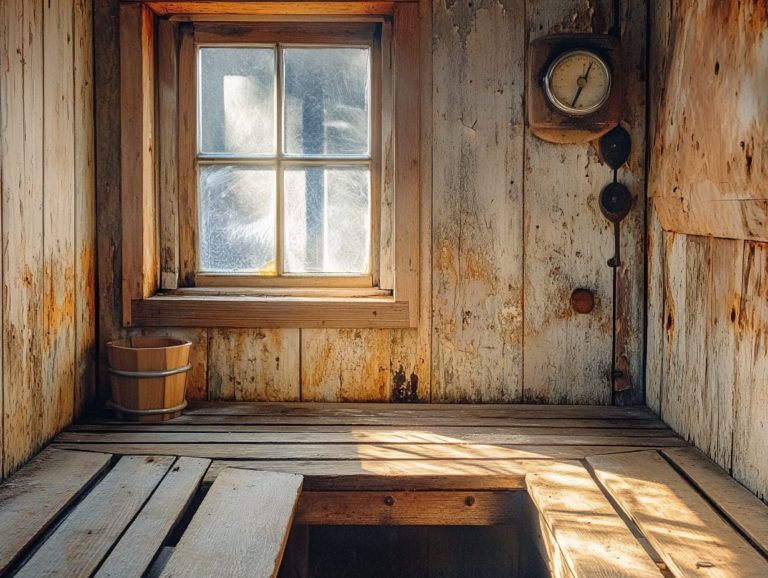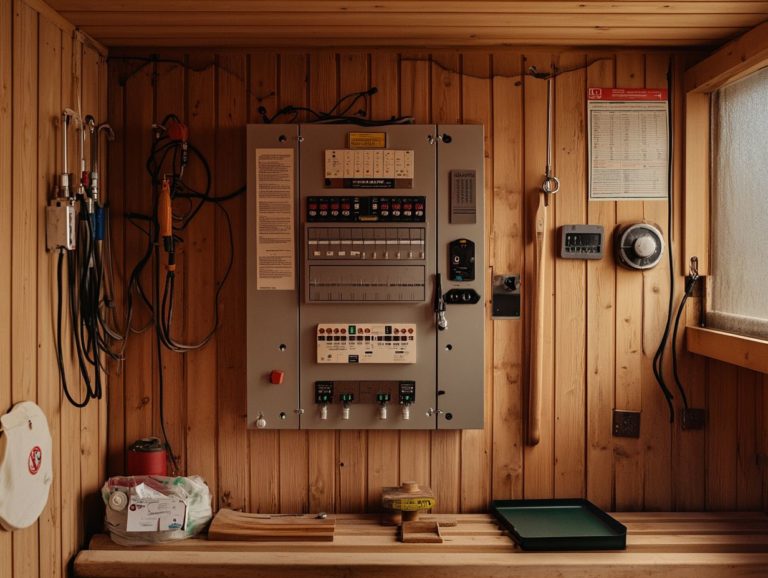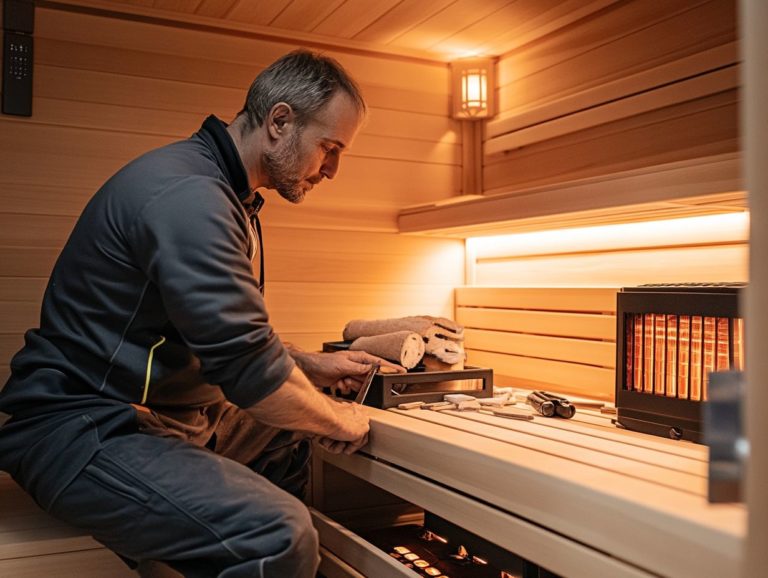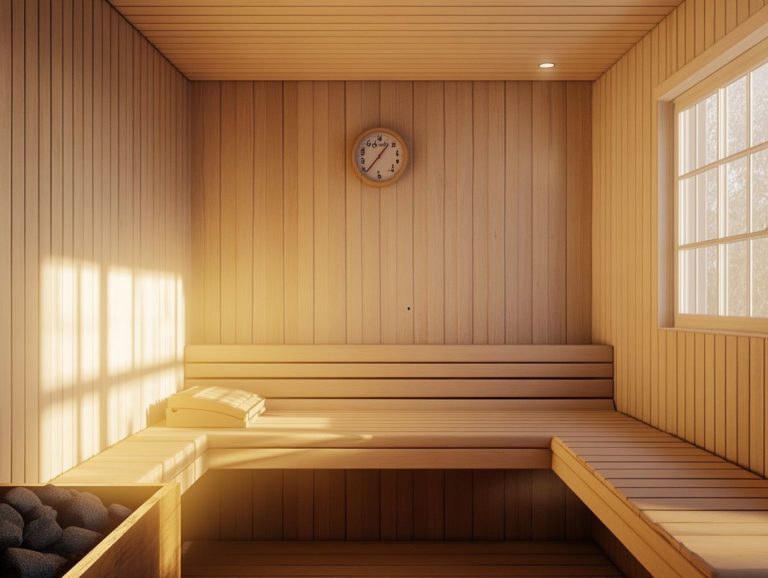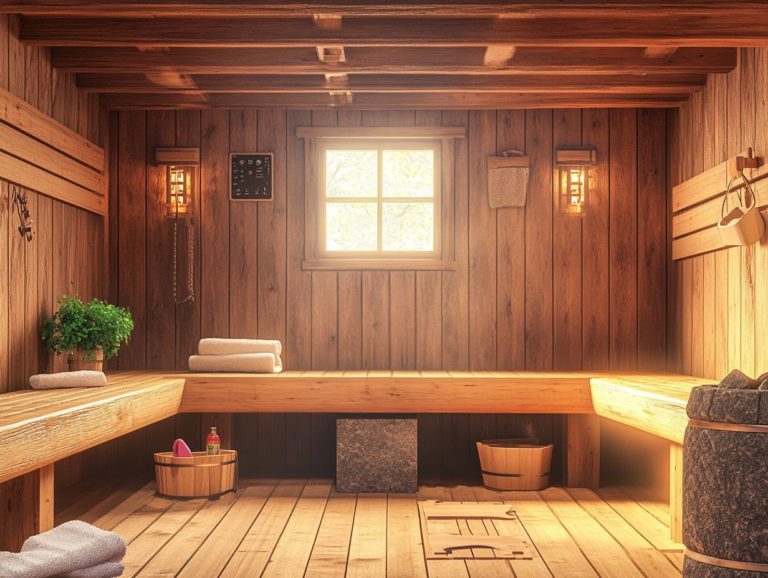Top 5 Sauna Maintenance Mistakes to Avoid
Maintaining a sauna is essential for guaranteeing a safe and enjoyable experience. Yet, many enthusiasts often overlook critical aspects of care.
From flawed cleaning routines to ignoring ventilation, these common missteps can significantly affect your sauna’s longevity and performance. Whether you’re a seasoned connoisseur or just beginning your sauna journey, recognizing these pitfalls will empower you to keep your space in pristine condition.
Get ready to discover the top five sauna maintenance mistakes and how to avoid them! This article offers insightful tips, ensuring you achieve the utmost enjoyment from your sauna experience.
Contents
- Key Takeaways:
- 1. Not Cleaning the Sauna Regularly
- 2. Using Harsh Chemicals
- 3. Not Properly Ventilating the Sauna
- 4. Not Maintaining the Sauna Heater
- 5. Not Monitoring Humidity Levels
- How Often Should a Sauna Be Cleaned?
- What Are the Best Products to Use for Sauna Cleaning?
- Why Is Proper Ventilation Important for a Sauna?
- What Are the Different Types of Sauna Heaters and How Do They Need to Be Maintained?
- What Is the Ideal Humidity Level for a Sauna and How Does It Impact Your Sauna Experience?
- What Are Some Tips for Sauna Maintenance?
- Frequently Asked Questions Regarding Sauna Care
- What are the five most common sauna maintenance mistakes?
- Why is it important to clean the sauna regularly?
- Can using harsh chemicals damage the sauna and affect hygiene?
- How does adjusting the sauna temperature properly affect maintenance and experience?
- Why is it important to replace sauna stones?
- How often should I check for leaks or damage in my sauna to maintain hygiene?
Key Takeaways:

- Regular cleaning of the sauna is essential to prevent the buildup of bacteria and mold.
- Using harsh chemicals can damage the wood and harm your health; opt for natural products instead.
- Proper ventilation is crucial to maintain a safe and comfortable environment inside the sauna.
1. Not Cleaning the Sauna Regularly
Neglecting to clean the sauna regularly can expose you to various health risks. It can also create an unpleasant atmosphere, ultimately detracting from your overall sauna experience.
Without proper hygiene standards, you might encounter sweat stains and unpleasant odors. You may also deal with the unwelcome presence of bacteria.
These issues can cause skin irritations and increase the chances of rashes or infections from extended contact with unclean surfaces. Inhaling mold spores may even lead to respiratory problems.
Establishing a cleaning routine that incorporates natural products and organic cleaners is vital. This practice helps maintain the sauna’s wooden interior while creating a safe and inviting environment.
Regular maintenance elevates your sauna experience and safeguards your overall well-being. This allows you to fully enjoy the restorative benefits of frequent sauna use.
2. Using Harsh Chemicals
Using harsh chemicals for sauna cleaning can risk the integrity of the wooden interior. These substances can introduce toxins into the environment, undermining the health benefits you seek.
These aggressive cleaners gradually wear down the sauna stones, impairing their ability to retain and distribute heat evenly. The outcome? Less efficient heating and unpleasant odors during your sessions.
Instead, choose organic cleaners and essential oils. They preserve the natural beauty of the wood while creating a safe atmosphere.
These natural alternatives effectively eliminate unwanted smells, ensuring your sauna retreat remains a haven of serenity and relaxation.
3. Not Properly Ventilating the Sauna
Proper ventilation in a sauna is essential for creating a comfortable ambiance. It ensures fresh air flows efficiently, preventing humidity buildup that can lead to unpleasant odors.
When airflow is inadequate, relaxation becomes challenging, and the body s natural process of eliminating toxins may be hindered. Proper ventilation is not merely a luxury but an absolute necessity.
A well-ventilated space allows your body to regulate its temperature more effectively. This amplifies the therapeutic benefits of your sauna session.
You can elevate your experience by adopting simple practices, such as leaving the door slightly ajar for a few minutes or using strategically placed vents to encourage fresh air circulation.
These steps enhance your comfort and contribute to a more invigorating sauna session, ensuring each visit is enjoyable and promotes your overall well-being.
4. Not Maintaining the Sauna Heater
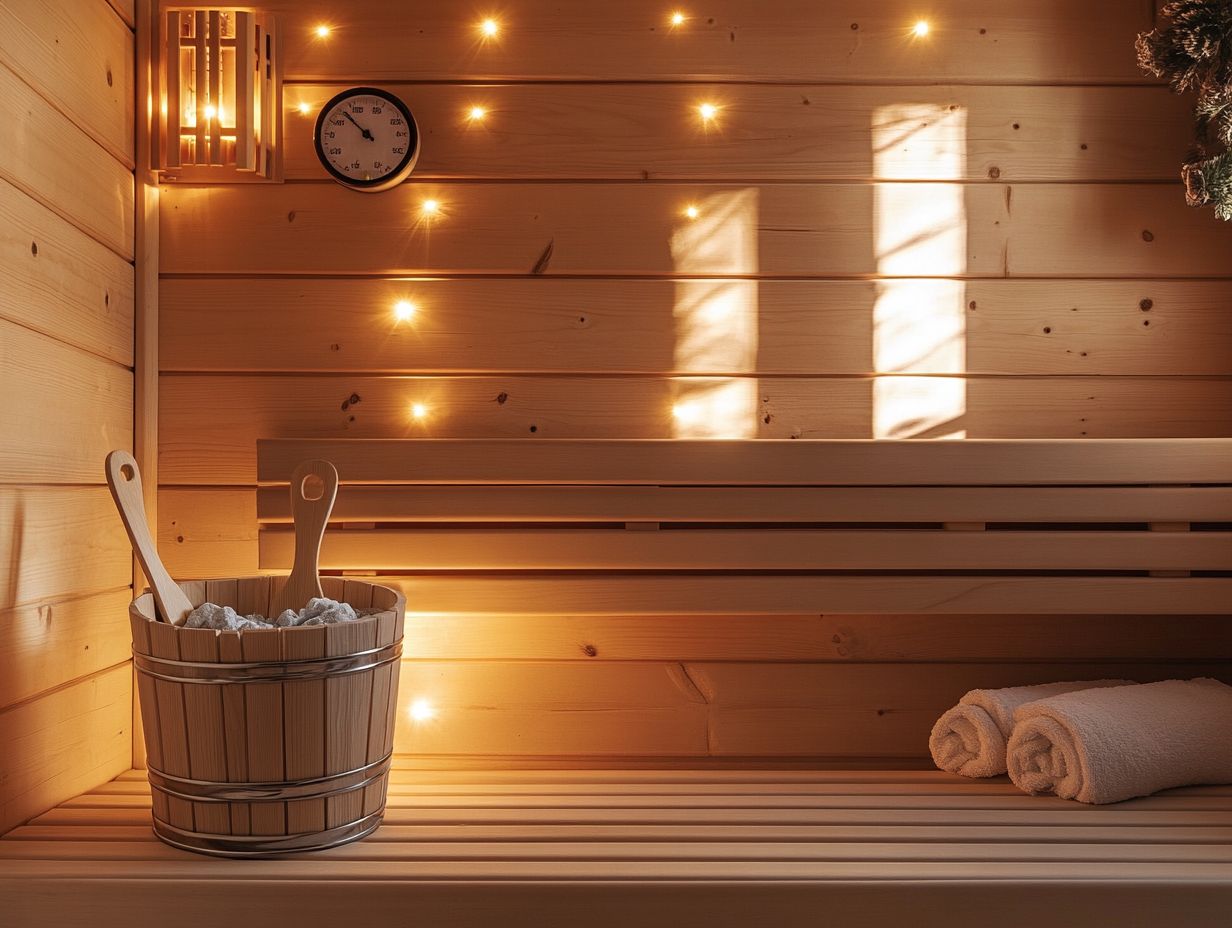
Neglecting to maintain your sauna heater can lead to serious health risks, malfunctions, and a less-than-ideal sauna experience. Proper care ensures optimal heating and extends the lifespan of your sauna facility.
It s essential to understand the different types of sauna heaters electric, wood-burning, and infrared each with unique maintenance requirements. For instance, electric heaters need regular checks of wiring and connections for safety and efficiency. Wood-burning heaters require frequent cleaning of ashes and chimney flues to prevent hazardous buildups.
Incorporate routine inspections into your maintenance schedule. This will help prevent issues and boost performance. This level of attention not only optimizes heating but also enhances the sauna’s design, creating a satisfying and healthful experience for everyone involved.
5. Not Monitoring Humidity Levels
Monitoring humidity levels is essential for maximizing the effectiveness of your sauna sessions. Improper humidity can lead to water loss, diminish health benefits, and create an uncomfortable experience for you and other sauna users.
Each type of sauna whether it s a traditional Finnish sauna, an infrared sauna, or a steam room has its ideal humidity level. This significantly impacts your overall experience. A traditional sauna typically operates at lower humidity, around 10-20%, allowing for higher temperatures that deliver a more intense heat sensation. Steam rooms thrive on elevated humidity levels, often reaching up to 100%, creating a soothing, moist environment that’s particularly beneficial for your respiratory system.
To enhance your comfort, consider using devices that measure humidity to monitor moisture levels. You might also want to control water spraying or use steam generators to make necessary adjustments.
By understanding and managing these humidity levels, you’re not just ensuring a pleasant sauna experience; you re also promoting relaxation and enjoying a range of health advantages, including improved circulation and skin hydration.
How Often Should a Sauna Be Cleaned?
Keeping your sauna clean is super important! The recommended cleaning schedules can vary based on how often you use it and the specific features of your sauna.
If you enjoy your sauna daily, adopt a more rigorous cleaning routine. This could involve quick clean-ups right after each use, paired with deeper cleaning sessions on a weekly basis. If you use your sauna less frequently, clean it after each session to prevent sweat and oils from building up. Be sure to check for any signs of mold or mildew right away!
Integrate a structured cleaning plan that includes daily maintenance tasks like wiping down surfaces and ensuring proper ventilation to enhance the longevity and overall hygiene of your sauna. Additionally, be aware of the most common sauna mistakes to avoid to ensure you get the most out of your experience.
What Are the Best Products to Use for Sauna Cleaning?
When it comes to cleaning your sauna, selecting the right products is crucial. Organic cleaners and natural products not only ensure effective cleaning but also help preserve the integrity of the sauna while enhancing your overall experience.
By choosing organic options, you can avoid harsh chemicals that could damage the wood and release harmful fumes in the enclosed space. Using essential oils like eucalyptus or lavender elevates the ambiance, turning your sauna into a rejuvenating sanctuary. These natural cleaners effectively dissolve dirt and grime while leaving behind a delightful aroma that lingers during and after your sessions.
Embracing eco-friendly products aligns with sustainable practices. This allows you to indulge in your wellness routine guilt-free while protecting both your health and the environment.
Why Is Proper Ventilation Important for a Sauna?

Proper ventilation in your sauna is essential for health benefits and a comfortable atmosphere. Fresh air circulation keeps humidity levels in check, preventing oppressive feelings.
The influx of fresh air acts as a rejuvenating force. This exchange of air helps remove excess moisture and unwanted odors, creating an inviting environment.
To achieve optimal airflow, consider your sauna’s design. Incorporate vents at both the lower and upper sections to balance air flow.
Keep air pathways clear for a better sauna experience. This directly contributes to a healthier and more enjoyable session.
What Are the Different Types of Sauna Heaters and How Do They Need to Be Maintained?
Sauna heaters electric, wood-burning, and infrared require specific maintenance to ensure safety and efficiency. Each type adds a unique touch to your sauna experience.
Understand how each type works. Electric heaters are very convenient, providing consistent temperatures with minimal effort. Wood-burning heaters offer an authentic experience, filling the space with warmth and aroma, but require regular firewood management.
Infrared heaters heat your body directly and are energy-efficient. However, they also need routine checks to maintain optimal performance.
Regular maintenance includes:
- Checking electrical connections for electric heaters
- Ensuring a dry wood supply and a clear flue for wood-burning options
- Inspecting infrared panels for any signs of wear
Periodically air out your sauna to prevent odors. Watch for loud sounds or temperature fluctuations; addressing issues promptly enhances your experience. For more details on resolving specific problems, refer to troubleshooting common sauna issues.
What Is the Ideal Humidity Level for a Sauna and How Does It Impact Your Sauna Experience?
The ideal humidity level is crucial for maximizing health benefits and enhancing your experience. Achieving the right balance helps with effective steam and relaxation.
Different saunas, like traditional Finnish saunas and steam rooms, need specific humidity levels. Traditional saunas thrive at around 10-20% humidity, encouraging sweating without overwhelming your senses.
Steam rooms maintain humidity levels exceeding 90%, opening airways and hydrating skin, making them perfect for detoxification.
Keep track of humidity with a hygrometer, which measures humidity. Adjust water levels on hot rocks or use a spray bottle for extra steam.
By managing humidity effectively, enjoy wellness benefits like improved blood circulation and easing muscle pain.
What Are Some Tips for Sauna Maintenance?
Effective sauna maintenance involves a series of best practices designed to preserve the sauna’s integrity and enhance your experience. A regular cleaning routine can significantly elevate your sauna enjoyment and wellness benefits.
To achieve this, give regular attention to various components, such as the sauna heater, sauna stones, wooden interior, and ventilation systems. Inspect the heater for efficiency to ensure it operates at its best. Additionally, be aware of the top detox mistakes to avoid by cleaning the stones and replacing them occasionally to maintain optimal heat retention. Keeping the wooden surfaces dry is crucial; it prolongs their lifespan, elevates hygiene standards, and minimizes water loss.
Check the ventilation systems regularly to ensure adequate air circulation and fresh air flow. This helps prevent stale air buildup and avoids potential health risks. Follow these steps to transform your sauna experience into a relaxing retreat!
For those interested, explore sauna accessories that enhance your sessions, such as sauna whisks or essential oils for a more enriching experience.
Frequently Asked Questions Regarding Sauna Care
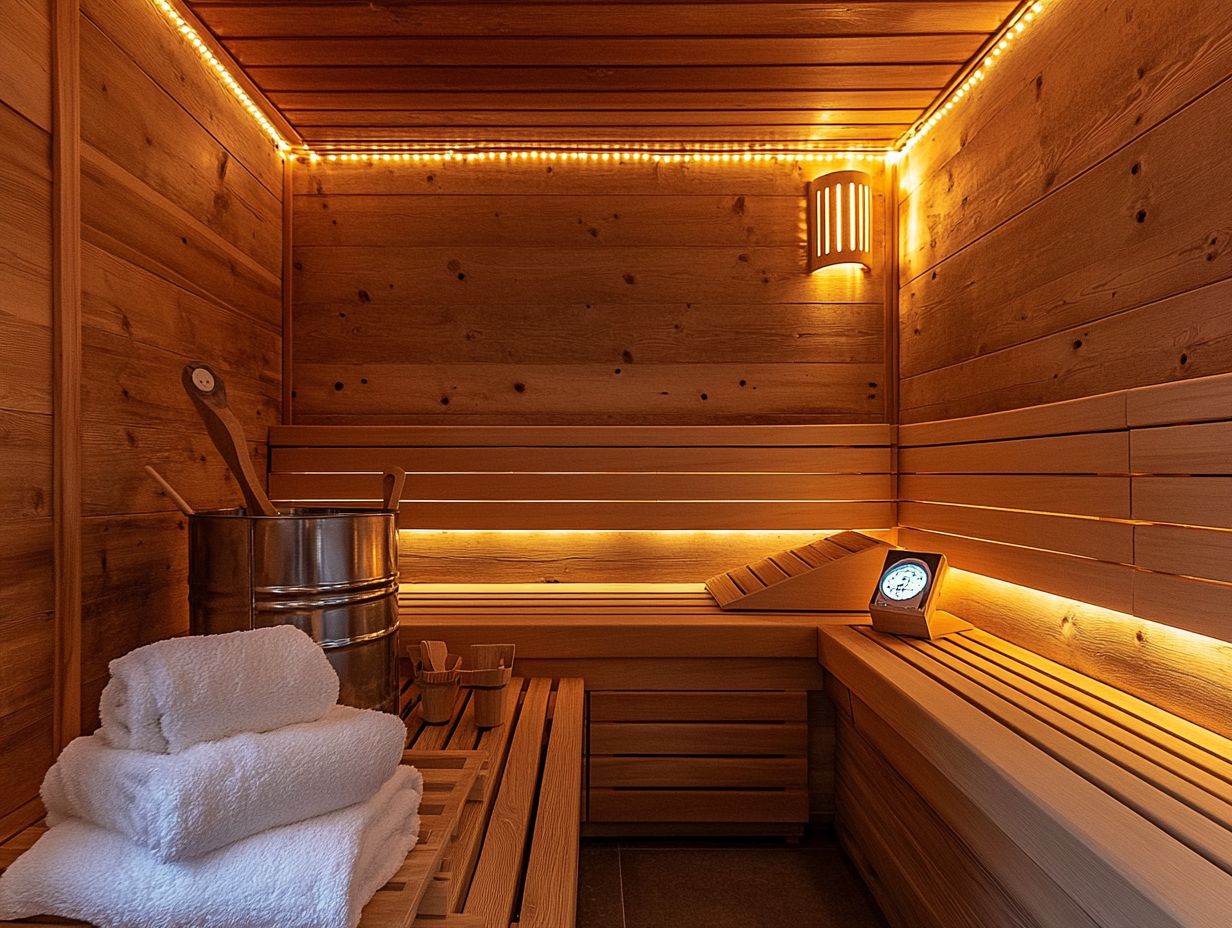
What are the five most common sauna maintenance mistakes?
- Not cleaning regularly
- Using harsh chemicals
- Incorrect temperature settings
- Neglecting sauna rocks
- Failing to check for leaks
Why is it important to clean the sauna regularly?
Cleaning the sauna regularly ensures a hygienic environment and helps prevent the growth of bacteria and mold. It also maintains the sauna’s performance and prolongs its lifespan, allowing for a more enjoyable sauna ritual.
Can using harsh chemicals damage the sauna and affect hygiene?
Yes, harsh chemicals can damage the sauna’s wood, causing it to warp or discolor. They can also irritate the skin and respiratory system of sauna users. That’s why it’s important to use mild, organic cleaners for maintenance.
How does adjusting the sauna temperature properly affect maintenance and experience?
Adjusting the sauna temperature correctly is crucial for both its performance and longevity. High temperatures can cause the wood to dry out and crack, while low temperatures can lead to bacterial growth and ineffective heating, creating potential health risks.
Why is it important to replace sauna stones?
Sauna stones play a crucial role in heating the sauna and creating the desired level of humidity. Over time, these rocks can deteriorate, becoming less effective. Replacing them regularly helps maintain the sauna’s efficiency and prolongs its lifespan, ensuring an optimal sauna experience.
How often should I check for leaks or damage in my sauna to maintain hygiene?
It is recommended to check for leaks or damage in your sauna at least once a month to maintain hygiene and functionality. Early detection of any issues can save you from expensive repairs in the future. Pay special attention to areas where the wood meets the floor and ceiling.

